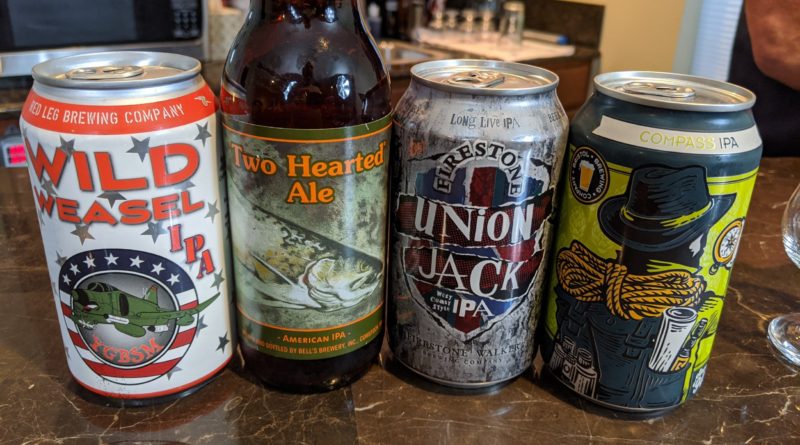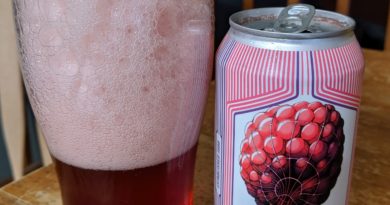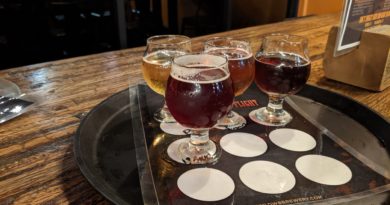American IPA Tasting – BJCP Category 21a
We managed to score two of the BJCP’s examples for this style, and grabbed a couple of local examples as well. This episode we’re tasting:
- Bell’s Two-Hearted Ale 7% 55 IBU – Comstock, MI
- Zymurgy (American Homebrewers Assn.) Reader poll Best Beer in America 3 years (17-19)
- Firestone Walker Union Jack 7% ABV 70 IBU – Paso Robles, CA
- Red Leg Wild Weasel 6.5% 48 IBU – Colorado Springs, CO
- Bristol Brewing Compass 6.5% 55 IBU – Colorado Springs, CO
It was good to have some examples of the classic “West Coast IPA”. Whenever I think of IPA, these are the types of beers that come to mind.
We also went off on a little bit of a tangent about the Bristol Brewing Compass IPA Birthday Box.
But back to IPAs. From the BJCP’s 21A – American IPA Style Description:
Overall Impression:
A decidedly hoppy and bitter, moderately strong American pale ale, showcasing modern American or New World hop varieties. The balance is hop-forward, with a clean fermentation profile, dryish finish, and clean, supporting malt allowing a creative range of hop character to shine through.
Appearance:
Color ranges from medium gold to light reddish-amber. Should be clear, although unfiltered dry-hopped versions may be a bit hazy. Medium-sized, white to off-white head with good persistence.
Aroma:
A prominent to intense hop aroma featuring one or more characteristics of American or New World hops, such as citrus, floral, pine, resinous, spicy, tropical fruit, stone fruit, berry, melon, etc.
Many versions are dry hopped and can have an additional fresh hop aroma; this is desirable but not required.
Grassiness should be minimal, if present. A low to medium-low clean, grainy-malty aroma may be found in the background.
Fruitiness from yeast may also be detected in some versions, although a neutral fermentation character is also acceptable.
A restrained alcohol note may be present, but this character should be minimal at best.
Any American or New World hop character is acceptable; new hop varieties continue to be released and should not constrain this style.
Flavor:
Hop flavor is medium to very high, and should reflect an American or New World hop character, such as citrus, floral, pine, resinous, spicy, tropical fruit, stone fruit, berry, melon, etc.
Medium-high to very high hop bitterness. Malt flavor should be low to medium-low, and is generally clean and grainy-malty although some light caramel or toasty flavors are acceptable.
Low yeast-derived fruitiness is acceptable but not required. Dry to medium-dry finish; residual sweetness should be low to none.
The bitterness and hop flavor may linger into the aftertaste but should not be harsh. A very light, clean alcohol flavor may be noted in stronger versions.
May be slightly sulfury, but most examples do not exhibit this character.
Mouthfeel:
Medium-light to medium body, with a smooth texture.
Medium to medium-high carbonation. No harsh hop-derived astringency.
Very light, smooth alcohol warming not a fault if it does not intrude into overall balance.
Comments:
A modern American craft beer interpretation of the historical English style, brewed using American ingredients and attitude. The basis for many modern variations, including the stronger Double IPA as well as IPAs with various other ingredients. Those other IPAs should generally be entered in the Specialty IPA style. Oak is inappropriate in this style; if noticeably oaked, enter in wood-aged category.
History:
The first modern American craft beer example is generally believed to be Anchor Liberty Ale, first brewed in 1975 and using whole Cascade hops; the style has pushed beyond that original beer, which now tastes more like an American Pale Ale in comparison.
American-made IPAs from earlier eras were not unknown (particularly the well-regarded Ballantine’s IPA, an oak-aged beer using an old English recipe). This style is based on the modern craft beer examples.




